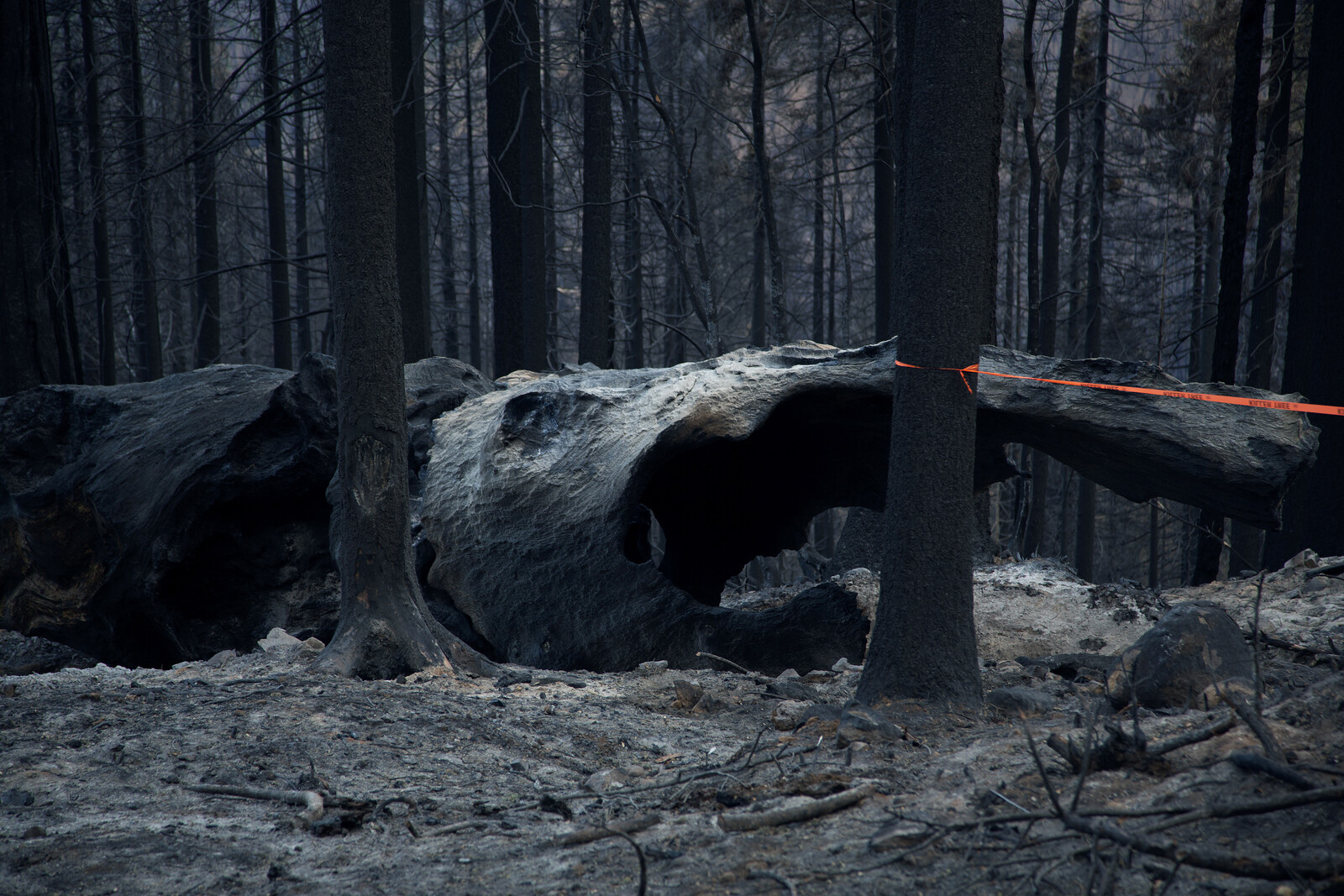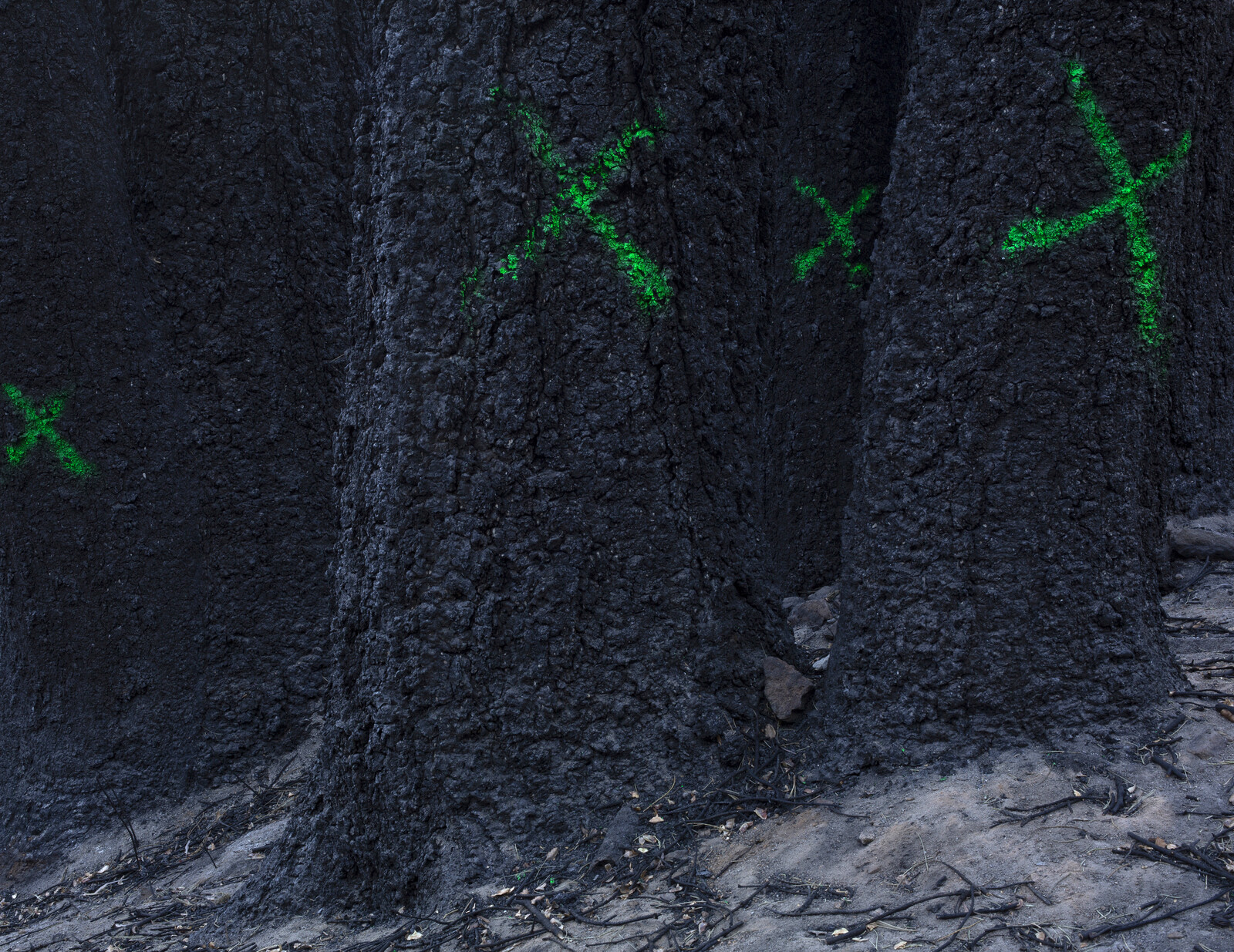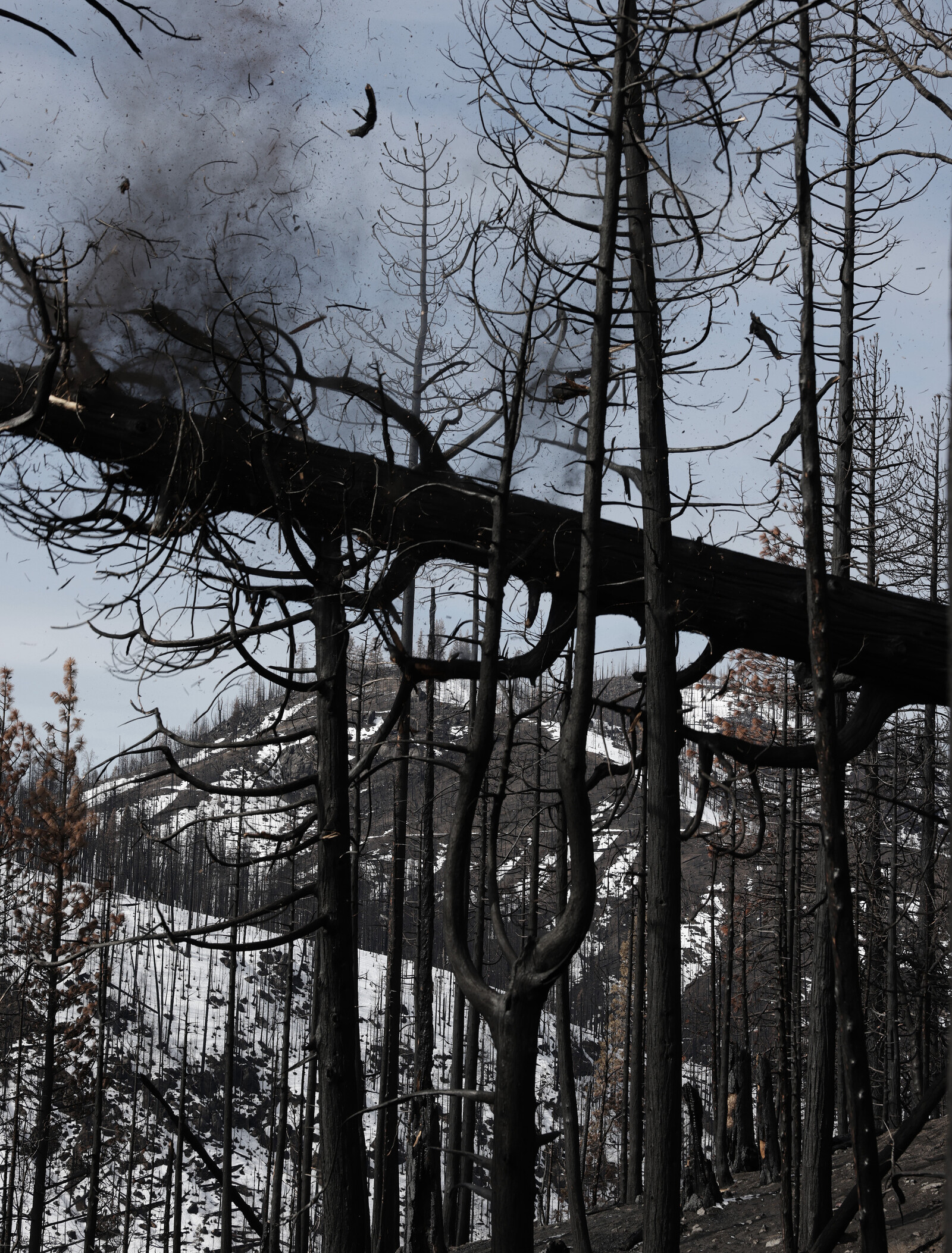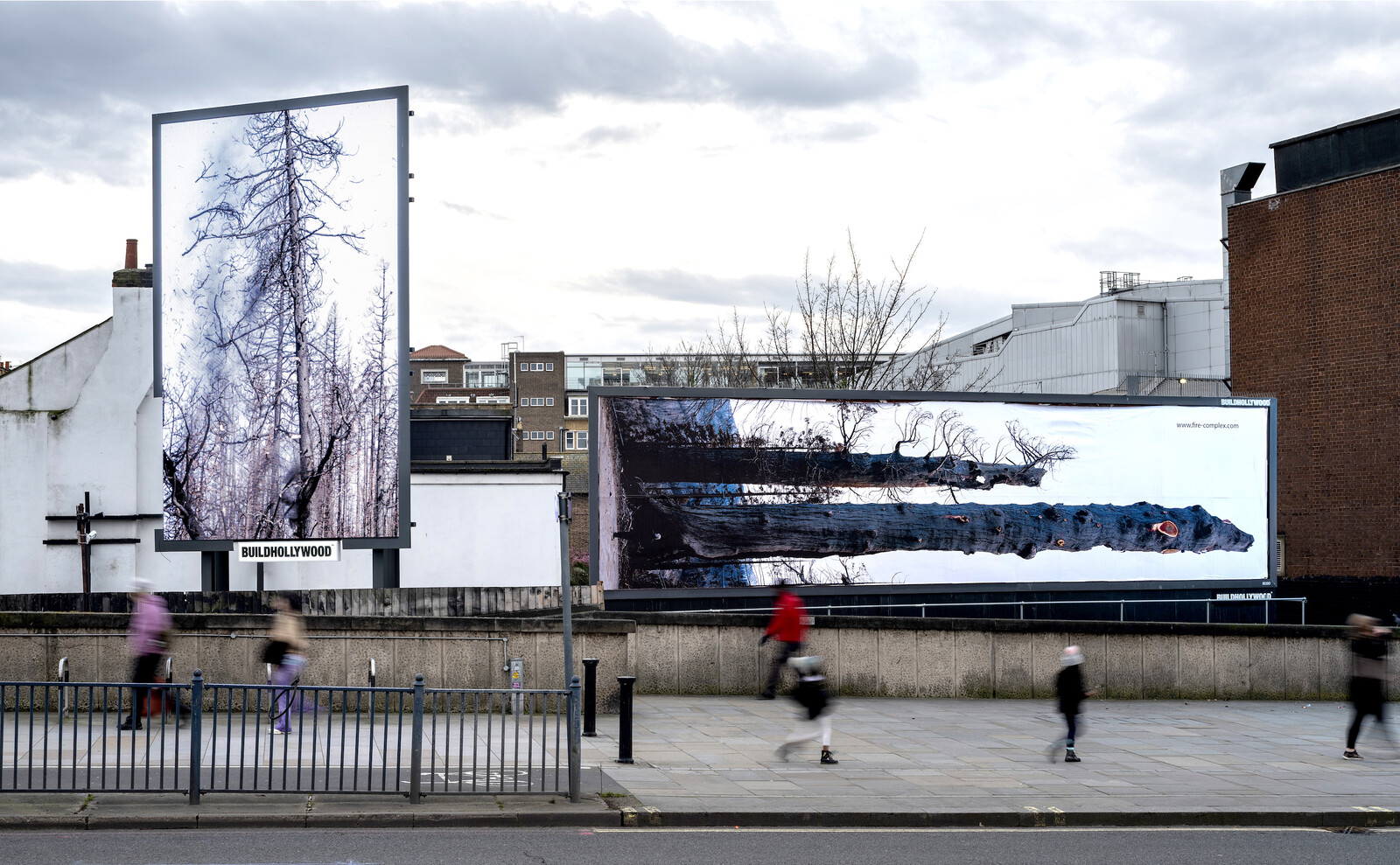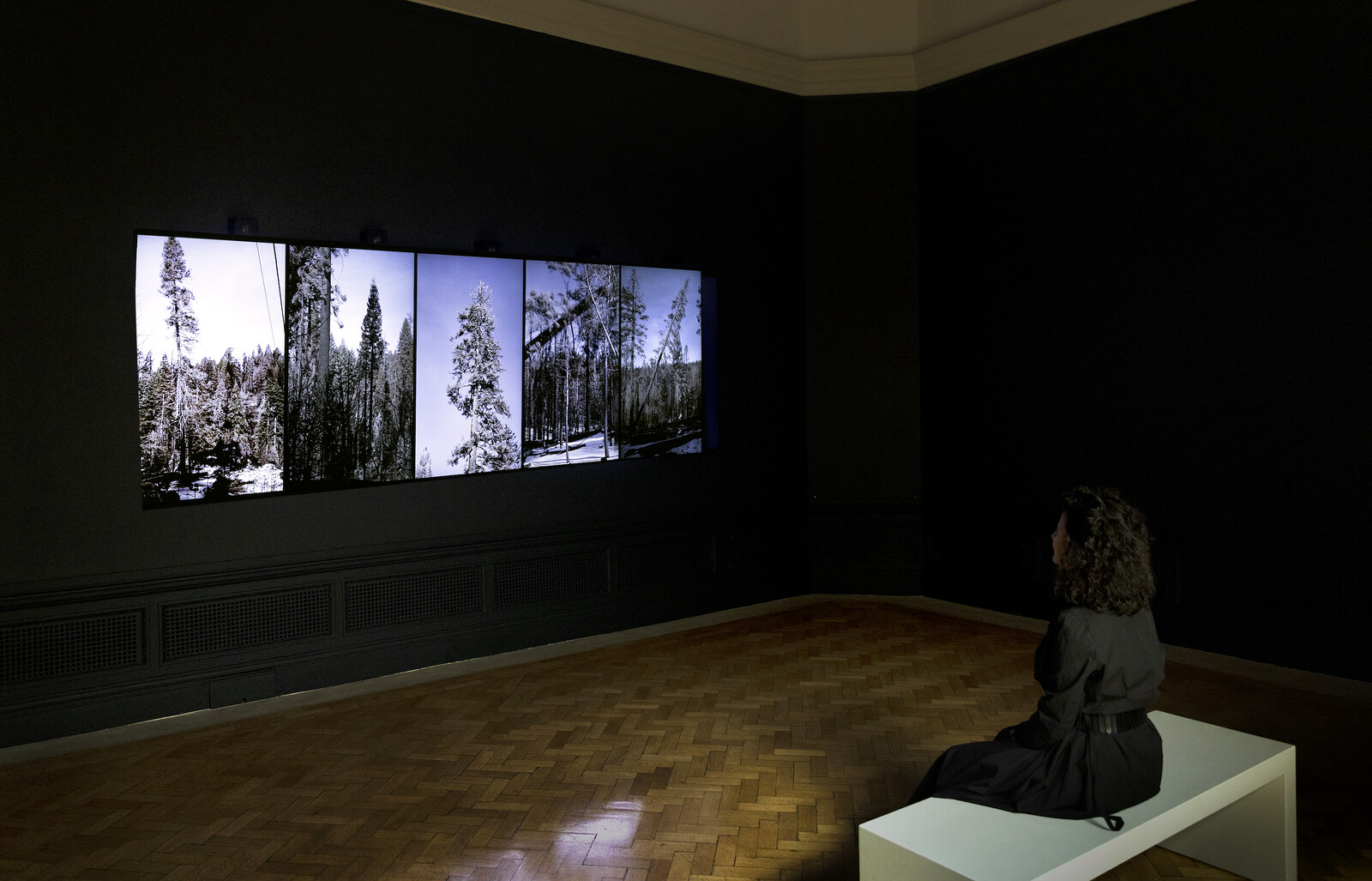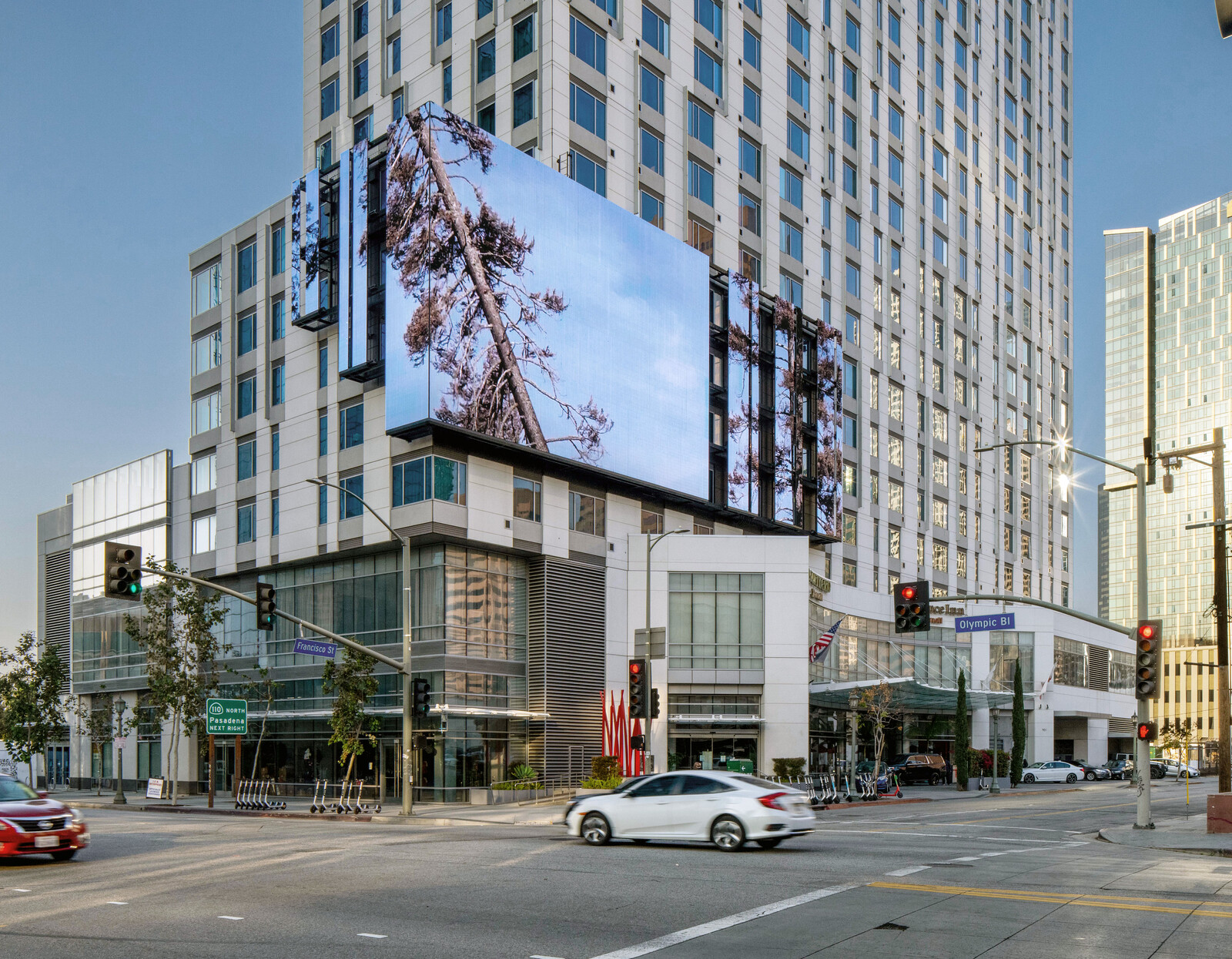In 2020, the Castle Fire wildfire swept through 174,000 acres of Sequoia National Forest, destroying an estimated 14 percent of the world’s giant sequoia population. Uta Kögelsberger embarked on a series of works and actions to render the destruction and its wider implications palpable, and to start to restore the land.
In her multi-screen video work Cull (2022)—which has been shown in different iterations in Los Angeles, London, and online—a dire spectacle unfolds before the viewer: a burnt forest with tall but stripped trees standing amid ash and snow. Giant sequoias, the largest and among the longest-living of trees, have historically survived these fires. Large firs, cedars, and other trees are being felled. The looping, 15-minute video is largely silent until the trees crash to the ground, shattering branches and throwing up huge clouds of ash. Some fall heavily, as we might expect, but others lightly, gently, as if with a sigh. To any lover of trees and forests, the work is deeply affecting.
Once, darkly beautiful scenes such as these—some of the static shots look like an apocalyptic variant of Ansel Adams—would have been experienced as sublime. In the current climate emergency, they are more immediately threatening: a vision of the end of the world. Alongside the video, Kögelsberger has initiated a replanting programme, and is making public works to raise awareness of the danger that such fires, made more frequent and fiercer by global heating, cause to the environment.
I spoke to Kögelsberger about the entangled complexities of her project “Fire Complex” (2020–ongoing), the competing agendas of those people and institutions which work in and manage the forest, and the prospects for non-capitalist action to repair the environment.
Julian Stallabrass: Can we begin with what is seen in Cull—what were you intending the effect to be?
Uta Kögelsberger: It is very hard for me to think about Cull without also thinking of the bigger multi-tentacled project called “Fire Complex,” which it sits nestled in. As a whole, the project sets about making a difference to the future through intervention in the public realm and through a replanting project.
Against that background, Cull attempts to appeal to the psychological and affective base by which we understand our relationship to the world—what Josephine Berry describes as sensing and sense-making, or sense-making through sensing.1 It communicates the experience of what it feels like to be faced with the devastating impact of climate change. Standing amongst these once-beautiful trees, some of which were over 2,500 years old at the time the fire came through, makes the loss of this amazing ecosystem palpable. Over the last fifteen years, I have watched this forest gradually being transformed by the stresses of human impact—drought, mismanagement, pine beetle infestations—until the wildfire eradicated it. It is hard to verbally describe how devastating it is to be faced with this level of destruction, especially knowing that we are all in some way responsible. So that is what I wanted people to feel when they view Cull. I wanted to place them there in this mess that we have created, and that we are now clearing away one tree at a time. But it does this against the background of the activist backdrop of “Fire Complex” and the replanting effort.
JS: How did you achieve these effects?
UK: At the Royal Academy, Cull is presented as a five-channel video installation on five vertical flatscreens set together to make one coherent whole.2 But that whole is disrupted by frames appearing and disappearing, at times creating a continuous horizon line, at others breaking down that coherence across space and time. It is a relentless cycle in which each tree is documented as it comes crashing to the ground, like a dead carcass, sometimes with such force that the earth shakes. In this orchestrated choreography, sounds punctuate the motion of collapsing trees which squeal under their own weight. The occasional sound of an axe acts like a metronome triggering the next drop of a tree, pacing the work into a score. Mostly the loggers cutting the trees are not visible in the frame. Every so often they appear, ant-sized, dwarfed by the scale of the disaster we have created.
Cull has been called a disaster movie, but the work has none of that artifice. The only camera motion is that created by the trees hitting the ground with such force that the camera moves. I think of Cull as a swansong of this environment. It is at once dramatic and understated. I am simply pointing my camera at what is happening. So even if, as shown at the Royal Academy, the work has strong pictorial qualities, it is not at all an idyllic landscape painting. Instead, it casts an unforgiving eye.
JS: Cull varies, though, in the different places that it is shown.
UK: Yes, Cull is a malleable work which started out on Instagram. In Los Angeles, the work was screened on the side of a high-rise building, where the trees appeared close to life size, and on paper billboards, juxtaposing the natural environment with a heavily trafficked city—cause and symptom brought together in the same space.3 In this public realm, the work had a completely different agency. “Fire Complex” has always reached beyond the gallery. It is a body of works, but it is also a call to action.
JS: In reading about forests lately and the very lengthy process of their destruction, there would appear to be a mix of hostility and distraction. Hostility in a widespread fear of wild forests and a disgust at their lack of utility so that they should either be felled, or managed like a factory to maximize profit. The subtitle to Robert Pogue Harrison’s 1992 book about forests and culture is The Shadow of Civilization. As he points out, that hostility goes back a long way—he describes the Roman destruction of North African forests. And that hostility also comes across strongly in Annie Proulx’s Barkskins (2016), a vast novelization of the rage to destroy forests since the seventeenth century, driven by the money to be made from cutting the old growth before anyone else can, but also out of fear and disquiet at the forest and its inhabitants, human and otherwise.
And distraction: I remember George Monbiot’s anguished statement that Brexit is a thousand times less important than the climate crisis. The war in Ukraine has done the same recently with more immediate effects on global heating. The media environment is geared up to mine attention from moment to moment, and some would say is hostile to sustained thought and action. Can you say more about how your multifarious work addresses both hostility and distraction?
UK: This is where the distribution of factual information through the Instagram handle @fire_complex comes into play.4 It builds a resource that brings together key points about forest management, wildfire prevention, and forest regeneration, and in so doing provides information about the increasing spread of wildfires in California. Despite its vast size, the Castle Fire was not among the biggest fires in what was, at the time, the most severe fire season on record, but it is now getting a lot of attention. This is, in part, because of the importance these old-growth forests have in respect of carbon sequestration, which is three times greater than in 150-year-old forests.
One of the concerns specific to the Californian forests is that they are hugely overgrown. This is directly related to close to a 100 years of fire prevention, mainly driven by the desire to protect human habitation. The result is that, where there were once 20 to 30 trees per square acre, there are now up to 200. This means that when a fire comes through, it burns at unprecedented temperatures because of the excess fuel, and the fire gets carried into the crowns of trees that would previously not have burned.
JS: The solution, I would think, is immediately bound up with competing financial interests.
UK: It would be more accurate to say that the solution is bound up with competing interests, not all of which are financial. However, one thing is clear, there has been a staggering disparity between the resources invested into fire prevention versus the cost of the wildfires. A study by UC Irvine established that the cost of the 2018 wildfires was 134 billion dollars. In the same year, the money invested into fire prevention was less than half a billion dollars.
But, just as importantly, this connects back to the more ideological question of whether the aforementioned imbalance in the ecosystem—based on human intervention, or rather lack thereof—needs to be re-addressed through human intervention, such as controlled burns and/or selective logging, is a hugely contested question. Among the opposing positions are for example those expressed by the logging lobby’s bumper sticker: “Log now or burn later.” Their thinking is that forests are viable financial assets to be exploited and that they should be logged rather than left to burn. On the other side of the spectrum are those lobbying against any kind of human intervention. Many experts now believe that this overprotection of the environment has made it prohibitively difficult to organize the kind of forest thinning and controlled burns that are essential to the survival of these forests and that have been a part of Native American practices for many years. Low-intensity burns are also a natural part of Californian forests. According to an employee of the Save the Redwoods League I spoke with it can take up to five years to organize a controlled burn.
It was clear to me that the visual work needed to tie in with this wider context. One element can’t exist without the other. When the work was exhibited, it was critical that it would present people with ways to engage. QR codes connected viewers to organizations that are actively involved in forest regeneration.
JS: So there is the attempt to engage the wider public and make it clear to them, both intellectually and emotionally, that they need forests as a matter of survival. But how do you work with those who live and work in the area?
UK: In parallel to the public-facing aspect of “Fire Complex,” the replanting effort that I initiated and devised brought together residents from three local communities in collaboration with Forest Services, Cal Fire, the Archangel Ancient Tree Archive, and over 100 volunteers from the Rotary Club. Doubtless my connection to the community helped me mobilize all these different parties. To date we have planted over 6,000 trees. In the first replanting effort we collaborated with the Archangel Ancient Tree Archive to rehome 150 giant sequoias. These had been cloned from the local 3,000-year-old Stagg and Waterfall trees, both of which are in the Alder Creek Grove which our community sits nestled within. The second effort, we planted saplings sourced from adjoining forests which had been donated by Cal Fire. It has been incredibly invigorating to see people set their personal and political differences aside to bring life back to the mountain. It felt like we were bringing together a group of citizens to participate in democratic participatory process.
A specific concern with these new high-intensity wildfires is that we don’t know if the forests will recover on their own. Another is that invasive species take over and make it impossible for local species to grow back. This has been observed in adjacent, heavily fire-damaged areas. This is part of the reason for the emerging strong push for reforestation.
JS: You may know that Sebastião Salgado set up the Instituto Terra in Brazil to restore a rainforest on his family land, which had been destroyed to pay for his university education. In their 2014 documentary The Salt of the Earth, Wim Wenders and Juliano Ribeiro Salgado showed part of that process, the successful regrowth of the forest and the return of flora and fauna. As in your project, there is much engagement with local people. This was done over a huge scale—nearly three million trees have been planted—and with the enormous resources of Salgado’s remarkable photography career and presence in the art market. It is both a hopeful realization of restoration, which Salgado says has even altered the local climate to bring back the rain, and binds up a number of contradictions, perhaps necessarily so, not least the connection to a voracious and destructive commercial art world.
Even so, I must admit that Salgado’s last words in the film—“the rain, the beautiful rain”— haunt me, especially now as we experience prolonged drought, and the plants and trees wither. Salgado’s project has been made in Brazil, where Bolsonaro’s regime is firmly on the side of those who log and burn. The combination of a capitalism that needs to continually expand to survive and a corrupted democracy seems a deadly one for the global ecosystem. Your project may be part of a solution, but can you say more about how you see the model operating more widely, as it complements others to address the powerful forces urging on the destruction?
UK: Instead of addressing the forces of capitalism head on, “Fire Complex” circumvents them by not depending on monetary exchange. Approximately two hundred people have contributed to the project in one way or another, almost all on an entirely pro-bono basis. We worked with a wide range of institutions: the billboard companies (Buildhollywood, Alchemy Media, and Standard Vision), the US Forest Services with their expert knowledge, Cal Fire who generously donated 6,000 saplings, the Arch Angel Ancient Tree Archive’s cloned saplings and their expertise in gaining media attention, the Rotary Club with their ability to mobilize volunteers, my partner and local communities. Finally, there were all the people responsible for the clear-up process who agreed to let me film them at work.
So, “Fire Complex” may be scalable in a different way than a project like the Instituto Terra. We can’t buy land or pay for labor. But perhaps it can act a model for collaborations between citizens and institutions without it being dependent on the exchange of capital. The fact that we are already being contacted by adjoining communities supports that line of thinking.
But maybe our biggest achievement to date is that, according to employees from Forest Services, our efforts at civic engagement as part of “Fire Complex” have helped to put the Save our Sequoias Act forward in Congress. This new bill proposes to channel 325 million dollars specifically towards wildfire prevention to save the giant sequoias and requires coordination between federal, state, tribal and local land managers.5 This bill, which is currently going through the channels, has in turn enabled Forest Services to declare an emergency under the applicable environmental laws that legalizes the critical removal of “hazardous fuels” from overpopulated sequoia groves in the interest of fire prevention. It is amazing to know that “Fire Complex” has played a part in this.
Josephine Berry, “The Agency of (Planetary) Feeling,” e-flux Journal, Issue #127 (May 2022): https://www.e-flux.com/journal/127/464399/the-agency-of-planetary-feeling/.
An excerpt from Cull is available to view online: https://vimeo.com/671735142.
An excerpt from Cull, shown in situ as part of Fire Complex, is available to view online: https://vimeo.com/675479690.
The Save our Sequoias Act is available to view online here.
